10 Types of Precision Shaft Machining Processes: All You Need to Know
 Apr 11,2025
Apr 11,2025

Shaft machining is a manufacturing process in which cylindrical objects are machined. We see Components of complicated shapes; shaft machining does the job to manufacture these objects with the highest precision and accuracy. Such high accuracy allows the parts to be used in critical applications such as aerospace or automotive. There are various shaft machining processes, and this article discusses a few of them. We will start by introducing what shaft machining is.
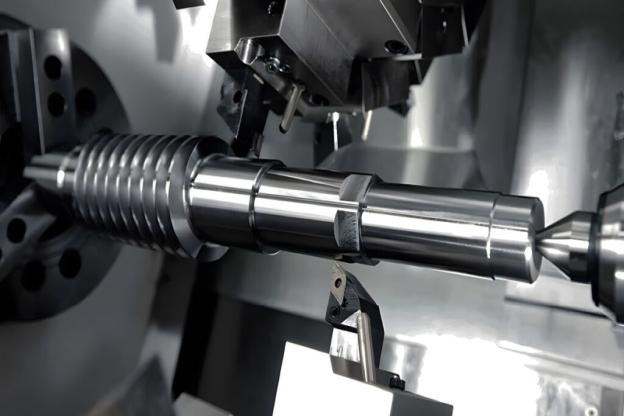
What is Shaft Machining?
Shaft Machining involves three operations, i.e. cutting, shaping and then machining an object “shaft”. It means shaft machining is a manufacturing process which converts raw material into a desired object. Shafts are important parts of any machine which transmit the torque or power to connected parts. To make parts of special design, custom shaft machining is also used.
What Is the Purpose of a Machined Shaft?
Machined shafts transmit power, torque and motion between components. They bear stress during the machining process. The common applications of machined shafts are:
- Vehicles
- Propellor Shafts
- Armature Shafts in electric motors
10 Types of Precision Shaft Machining Processes
As we mentioned earlier, there are various shaft machining operations, but you will study 10 of those operations in this section. We will see which operation is suitable for a respective application.
1. CNC Turning
For custom driveshaft production, CNC turning ensures high accuracy. Cylindrical components are machined using CNC turning.
Machining Principle
- An object keeps rotating while a stationary cutting tool removes the material
Applications
- Cylindrical Shafts
- High-accuracy custom shafts
Characteristics
- One of the best operations for manufacturing cylindrical profiles with tight tolerances
2. CNC Milling
CNC Milling manufacures complex-shaped parts through material removal. It is a shaft machining process in which multiple milling tools are used during the operation.
Machining Principle
- The working principle is the opposite of the CNC turning process
- Stationary workpiece while the rotary cutting tools remove the material from the workpiece
Applications
- Complex geometries
- Profiles for splined shafts and more
Characteristics
- For producing intricate shapes and profiles, it is considered a versatile shaft machining operation.
3. CNC Grinding
CNC grinding is used for producing smooth surfaces of the machine products. The work remains smooth and flawless due to the automation feature.
Machining Principle
- Abrasive wheels remove excessive material from the surface
Applications
- Produces precision shafts of smooth surfaces
Characteristics
- An excellent choice to achieve tight tolerance and smooth finishes
4. EDM (Electrical Discharge Machining)
A non-traditional process removes material from the surface using electrical discharges. It is only applicable for conductive materials.
Machining Principle
Place the workpiece between two electrodes, provide an electric field and then spark between electrodes to erode the material.
Applications
For intricate parts requiring minimal material deformation.
- Surgical Instruments
- Precision Gear Manufacturing
- Prototype production
Characteristics
- For hard, conductive and complex shapes, choose the EDM process.
5. Thread Rolling
A cold-forming process where hardened steel dies, mirroring the desired thread profile, deforming a metal blank into a thread form, strengthening the threads and improving fatigue resistance.
Machining Principle
Pass the wire or rod between two flat plates, one moving and the other stationary, with a thread engraved on the surface.
Applications
- Threaded fasteners
- Pipe Fittings
- Studs' production
Characteristics
To produce strong, durable threads without material removal, this process is recommended.
6. Broaching
Broaching creates internal or external shapes using a toothed tool to remove material from a workpiece in a single pass.
Machining Principle
- Toothed tool removes material from the workpiece in linear motion
Applications
- Keyway Cutting
- Spline Cutting
- Turbine Disk Slots
- Automotive Steering Shaft
Characteristics
This machining operation is suitable for internal features because of its high precision.
7. Gear Hobbing
Gear hobbing produces gear cutting using a specialized milling machine. It's a continuous machining process.
Machining Principle
- A hub cuts gears into required dimensions
Applications
- Gear Shafts
- Sprockets
- Chain wheels
- Cluster Gears
Characteristics
It is an efficient process for producing gear teeth with high accuracy.
8. Deep Hole Drilling
This machining process drills holes through the thickness of the body. The drills are used for this purpose.
Machining Principle
- Insert the drill where to produce a hole and then turn on the machine.
Applications
- Hollow Shafts
- Aircraft Landing Gear Components
- Injection Molds
Characteristics
It is an ideal operation for straightness and precision in deep holes.
9. Cold Rolling Forming
Cold roll forming produces required parts using rolling the sheets between two or more rollers at room temperature.
Machining Principle
Pass the metal sheets between two or more rollers, deform them into desired shaped parts.
Applications
- Lightweight shafts
- Railway components
- Tubes and pipes
Characteristics
This process increases strength due to strain hardening and surface smoothness.
10. Rotary Swaging
In this process, rotating hammers or dies shape the metal sheets into products.
Machining Principle
- Place the metal sheet between the rotating hammers or dies
Applications
- Tubes
- Bars or wires
- Tapered shafts
Characteristics
This process produces smooth and tapered profiles.
Tables of Precision Shaft Machining Processes
Summary of the above discussion:
|
Process |
Machining Principle |
Typical Applications |
|
CNC Turning |
Rotating workpiece, cutting tool |
Custom driveshafts, cylindrical shafts |
|
CNC Milling |
Rotary cutters, stationary workpieces |
Splined shafts, complex geometries |
|
CNC Grinding |
Abrasive wheels |
Precision shafts, smooth finishes |
|
EDM |
Electrical sparks |
Intricate parts, minimal deformation |
|
Thread Rolling |
Material deformation |
Threaded shafts |
|
Broaching |
Linear cutting motion |
Internal splines, automotive shafts |
|
Gear Hobbing |
Hob cutting tool |
Gear shafts |
|
Deep Hole Drilling |
Drilling deep holes |
Hollow shafts |
|
Cold Rolling Forming |
Room temperature deformation |
Lightweight shafts |
|
Rotary Swaging |
Rotary tools for diameter reduction |
Tapered shafts |
This table is easy to read but with more information.
Types of Machined Shafts and Their Applications
Now, you will study different types of machined shafts and their applications in this article:
Hollow Shafts
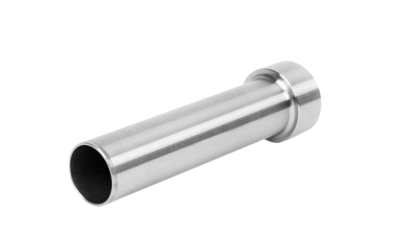
Applications
- Golf Shafts, PTO Shafts
Characteristics
- Lightweight and efficient for specific uses
Threaded Shafts
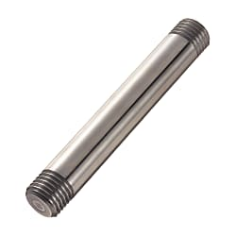
It is a long rod containing threads on both ends. See the above image for a better understanding.
Characteristics
- Essential part of the machinery for secure connections
Applications
- Drive Shafts
- Electrical industry
- Plumbing
Keyed Shafts
This shaft ensures a smooth transfer of torque by connecting the motor securely to a shaft.
Characteristics
It is a vital component for secure torque transmission in machinery.
Applications
- Power Transmission
- Assembly and Disassembly
Splined Shafts
This shaft contains teeth or ridges cut into it. These teeth support fixing it into other parts.
Characteristics
It is a common shaft in driveline performance and driveline shops.
Applications
- Driveline Performance
- Automotive Systems
Tapered Shafts
It's a tapered shaft where the diameter increases or decreases along the length. That taper in the shaft supports a secure connection.
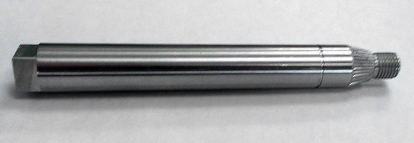
Characteristics
It provides secure connections in high-stress applications.
Application
- Used in precision applications like drive shaft manufacturing
- Golf Club Shafts
- Hydraulic Hubs
Shaft Manufacturing Process: From Design to Production
This section is a brief guide to the shaft manufacturing process from design to production.
Design and Programming
- For designing, CAD/CAM software is used
- Mastercam software for shaft machining programming
Machine Setup
Preparing shaft machines for the required operations. Check the complete setup either anything is missing or not.
Machining and Finishing
Multiple techniques, such as turning, milling, etc., are used in machining. While finishing involves heat or surface treatments.
What Are Commonly Used in Shaft Materials?
You will find various materials in this section which are used in shaft machining. These materials are equipped with their properties, which is why they are used according to the requirements of the shaft.
Steel
Characteristics
Some notable properties are:
- High strength and durability
- Good corrosion resistance
Applications
- Steel driveshaft
- Gear shafts
Aluminum
Characteristics
- Lightweight
- High strength-to-weight ratio
- Ductile, Durable and corrosion resistant
Applications
- Aerospace industry (aluminium driveshafts)
Stainless Steel
Characteristics
Stainless Steel is highly durable material and most in shafts of heavy machinery. It shows excellent corrosion resistance because of the passive layer of Cr2O3.
Applications
- Shaft seal manufacturers and driveshaft parts
Titanium
Characteristics
- Excellent fatigue strength
- High strength-to-weight ratio
Applications
- Used in aerospace shafts i.e. rotor shafts
- Marine shafts
- Propeller shafts
Nickel Alloys
Characteristics
- Excellent mechanical properties
- Used for extreme conditions
Applications
- Marine shafting
- Aerospace shafting
Surface Finishing Options for Custom-Machined Shafts
To avoid issues like corrosion or erosion, various surface finishing operations are available. You can study some of them below in this section:
Anodizing
It is an electrochemical process which increases the thickness of the natural oxide layer.
- Protective coating for PTO shafts and other sensitive applications
Polishing
This surface finishing process increases surface smoothness by applying chemical treatments such as nitric acid or sulfuric acid.
- Improves appearance and reduces wear in machined shafts
Electroplating
In this process, a very thin layer of metal is applied on the subjective material's surface using an electric current.
- Enhance corrosion resistance in drive shaft parts
Passivating
In this process, free iron from stainless steel is removed and allows the formation of a protective oxide layer to enhance the corrosion resistance of the shaft.
- Corrosion protection, especially for stainless steel shafts
Bead Blasting
- A stainless-steel workpiece is placed in a container
- Fast-moving beads are thrown onto the workpiece
- Creates a uniform surface texture for machined shaft components
What Is Large Shaft Machining?
In this process, those shafts are machined, which are significantly greater in terms of diameter, length and weight than the standard size.
How Big is Large Shaft Machining?
Specialized equipment such as a heavy-duty Lathe machine is required for handling these large shafts.
Materials and Techniques for Large Shaft Machining
CNC turning or precision grinding is used for machining the large shafts. Materials can be Al, Ti or steel, depending on the requirements.
Common Types of Shafts and Their Industry Applications
Let us briefly explain the different types of shafts and their industry applications in this section.
Drive Shaft
This type of shaft enables movement by transmitting power from the engine to the wheels.
Applications
- Automotive
- Agricultural machinery
- Driveline performance
Propeller Shafts
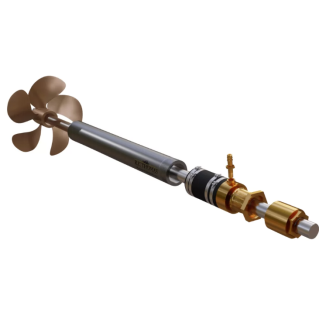
This shaft spins at high speed and transfers torque from the gearbox to the rear axle or differential.
Applications
- Used in marine and aerospace industries
Axle Shafts
This shaft transmits rotational force from the transmission system to enabled wheels and other parts. It is considered a load-bearing component.
Applications
- Used in vehicles and heavy machinery
Armature Shafts
It performs two important functions. It conducts current over the field, thus generating shaft torque within an active machine. Then, it generates an electromotive force. Armature shaft manufacturers in India manufacture this shaft mainly.
Applications
- Mainly made for electric motors
Golf Shafts
- While playing Golf, our swing produces energy which the golf shafts transfer to the ball.
Applications
- Tailored to specific performance needs in the sport, i.e. Golf
Choosing the Right Shaft Manufacturer for Your Project
First, you should know the material, dimensions, precision and applications, then the manufacturer's level of advancement in machinery, expertise and finally, costs for production.
Shaft Manufacturers in Tuofa, China
Shaft Manufacturers in Toufa make sure the shafts are produced with great accuracy and tight tolerances.
Local vs. Global Suppliers
Factors like cost, lead time and the expertise of the manufacturers help us to decide between local and global suppliers.
Specialized Shaft Manufacturers
These manufacturers produce niche products such as graphite iron shafts or drive axle ring gears.
Tuofa China Shaft Machining Capabilities
Toufa is a Chinese company which fulfills all the criteria to manufacture highly precise shafts. We are equipped with the most experienced manufacturers and advanced machines. We can also manufacture custom driveshafts, PTO shafts, etc. We will deliver your order within the shortest possible time and at attractive rates.
4 Tips for Designing and Manufacturing Custom Shafts
If you follow these tips, you can enhance precision in manufacturing custom shafts.
Dimensional Accuracy
- Ensure tolerance and precise fits, especially in long shaft machining
Material Selection
- Select materials according to their applications, e.g. aluminium driveshaft for lightweight applications.
Shaft Alignment
- Make sure of correct alignment during manufacturing to prevent mechanical failure.
Stress Analysis and Load Considerations
- Do proper testing, particularly for drive shaft parts, to ensure longevity and performance
Conclusion
This article concludes that precise shaft machining is very important because it ultimately affects the performance of the machine. To make a shaft, the material is selected based on its application. Various shaft types are available in the market, which vary in size, design, materials and applications. To find the best manufacturer, analyze its qualities, reputation, and costs for production.
FAQs
What is a Shaft in a Machine?
It transfers power or motion to the connected components in the machinery.
What are the most common materials used for shaft manufacturing?
The most common materials used for shaft machining include steel, titanium and Ni-based alloys.
How do I choose the best machining technique for my shaft?
The level of precision for your shafts matters the most in selecting the best machining technique. You can use CNC machines for the best results.
What is the cost of a custom driveshaft or drive shaft replacement?
The material and level of complexity in the design and manufacturing process decide the costs for custom driveshafts.
 Tel/WeChat:
Tel/WeChat:  Email:
Email: 
 Home
Home
 Types of Bearings Explained: Main Types, Applications & Housing
Types of Bearings Explained: Main Types, Applications & Housing 







